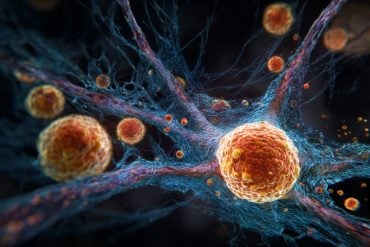Summary: The loss of blood flow autoregulation caused by diabetes is the result of the disruption of the TRPV2 protein. Even in the absence of diabetes, disrupted blood flow autoregulation causes damage closely resembling that seen in diabetic retinopathy.
Source: Queen’s University Belfast
Researchers at Queen’s University Belfast have uncovered a key process that contributes to vision loss and blindness in people with diabetes. The findings could lead to new treatments that can be used before any irreversible vision loss has occurred.
Diabetic retinopathy is a common complication of diabetes and occurs when high blood sugar levels damage the cells at the back of the eye, known as the retina.
There are no current treatments that prevent the advancement of diabetic retinopathy from its early to late stages, beyond the careful management of diabetes itself.
As a result, a significant proportion of people with diabetes still progress to the vision-threatening complications of the disease.
As the number of people with diabetes continues to increase globally, there is an urgent need for new treatment strategies, particularly those that target the early stages of the disease to prevent vision loss.
The retina demands a high oxygen and nutrient supply to function properly. This is met by an elaborate network of blood vessels that maintain a constant flow of blood even during daily fluctuations in blood and eye pressure. The ability of the blood vessels to maintain blood flow at a steady level is called blood flow autoregulation. The disruption of this process is one of the earliest effects of diabetes in the retina.

The breakthrough made by researchers at Queen’s University Belfast pinpoints the cause of these early changes to the retina.
The study, published in the journal JCI Insight, has discovered that the loss of blood flow autoregulation during diabetes is caused by the disruption of a protein called TRPV2.
Furthermore, they show that disruption of blood flow autoregulation even in the absence of diabetes causes damage closely resembling that seen in diabetic retinopathy.
The research team are hopeful that these findings will be used to inform the development of new treatments that preserve vision in people with diabetes.
Professor Tim Curtis, deputy director at the Wellcome-Wolfson Institute for Experimental Medicine at Queen’s and corresponding author, explains, “We are excited about the new insights that this study provides, which explain how the retina is damaged during the early stages of diabetes.
“By identifying TRPV2 as a key protein involved in diabetes-related vision loss, we have a new target and opportunity to develop treatments that halt the advancement of diabetic retinopathy.”
About this visual neuroscience and diabetes research news
Author: Press Office
Source: Queen’s University Belfast
Contact: Press Office – Queen’s University Belfast
Image: The image is credited to the researchers
Original Research: Open access.
“Loss of TRPV2-mediated blood flow autoregulation recapitulates diabetic retinopathy in rats” by Michael O’Hare et al. JCI Insight
Abstract
Loss of TRPV2-mediated blood flow autoregulation recapitulates diabetic retinopathy in rats
Loss of retinal blood flow autoregulation is an early feature of diabetes that precedes the development of clinically recognizable diabetic retinopathy (DR).
Retinal blood flow autoregulation is mediated by the myogenic response of the retinal arterial vessels, a process that is initiated by the stretch‑dependent activation of TRPV2 channels on the retinal vascular smooth muscle cells (VSMCs).
Here, we show that the impaired myogenic reaction of retinal arterioles from diabetic animals is associated with a complete loss of stretch‑dependent TRPV2 current activity on the retinal VSMCs. This effect could be attributed, in part, to TRPV2 channel downregulation, a phenomenon that was also evident in human retinal VSMCs from diabetic donors.
We also demonstrate that TRPV2 heterozygous rats, a nondiabetic model of impaired myogenic reactivity and blood flow autoregulation in the retina, develop a range of microvascular, glial, and neuronal lesions resembling those observed in DR, including neovascular complexes. No overt kidney pathology was observed in these animals.
Our data suggest that TRPV2 dysfunction underlies the loss of retinal blood flow autoregulation in diabetes and provide strong support for the hypothesis that autoregulatory deficits are involved in the pathogenesis of DR.






